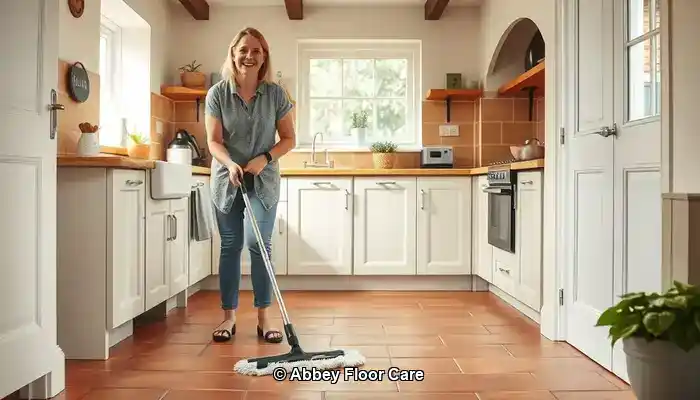
Last Updated on September 29, 2025 by David
Master the Art of Maintaining Spotless Terracotta Floors with Expert Techniques
-
- Understanding the Porous Nature of Terracotta highlights its susceptibility to rapid dirt buildup, particularly in humid climates such as Surrey.
- Essential Sealing Practices are crucial for safeguarding the tiles from moisture and dirt infiltration, ensuring the surface remains intact and visually appealing.
- Importance of Regular Maintenance—Incorporating daily sweeping and weekly mopping with pH-neutral cleaners is essential to maintain the aesthetic beauty of your tiles.
- Avoiding Damaging Chemicals and Steam Mops is vital as they can harm the sealant and damage the surface of the tiles.
- Choose Eco-Friendly Cleaning Solutions, especially in households with pets or young children.
- Engaging Professional Restoration Services can ensure thorough cleaning and resealing, providing long-lasting protection for your terracotta.
- Strategically Placing Rugs and Mats in high-traffic areas effectively reduces dirt transfer onto the tiles.
- Effective Moisture Management—Ensuring proper ventilation and promptly cleaning spills is essential in preventing staining and the growth of mould.
What Causes Terracotta to Accumulate Dirt So Quickly?
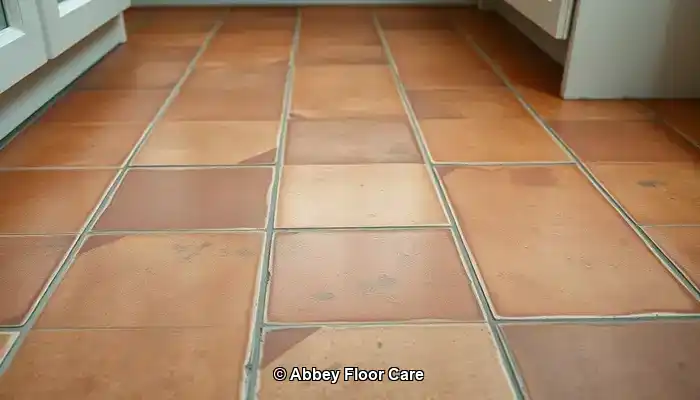
Terracotta tiles are a beautiful choice for flooring, especially in traditional and rustic-style homes throughout Surrey. The warm hues and natural textures of these tiles enhance the character and warmth of any living space. However, despite their visual appeal, terracotta is often prone to rapid accumulation of dirt—recognizing the underlying reasons for this can lead to effective cleaning and maintenance practices that keep these beautiful surfaces looking their best.
Top Recommendations: Best Products for Everyday Care of Terracotta Floors
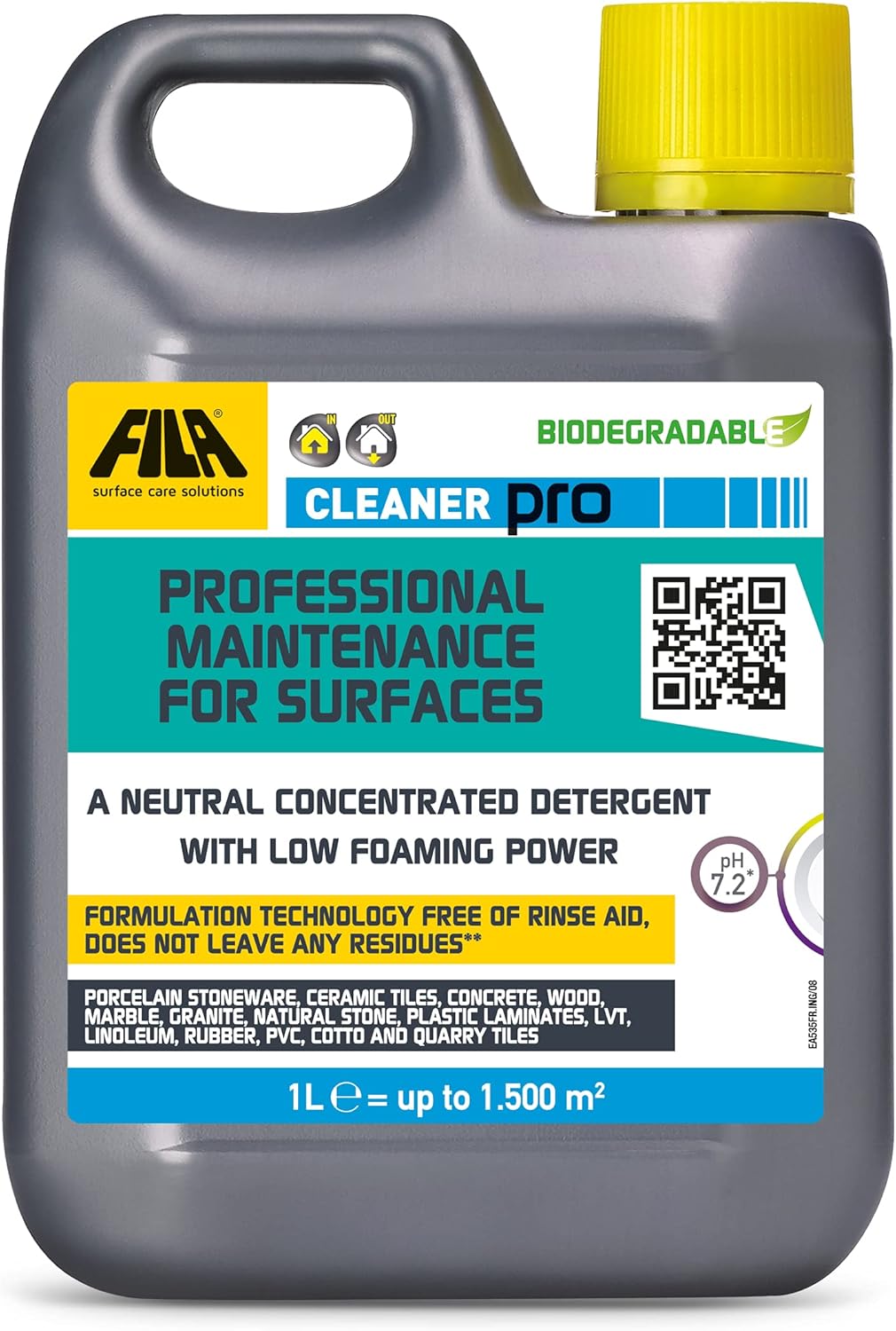
Fila Pro Floor Cleaner
|
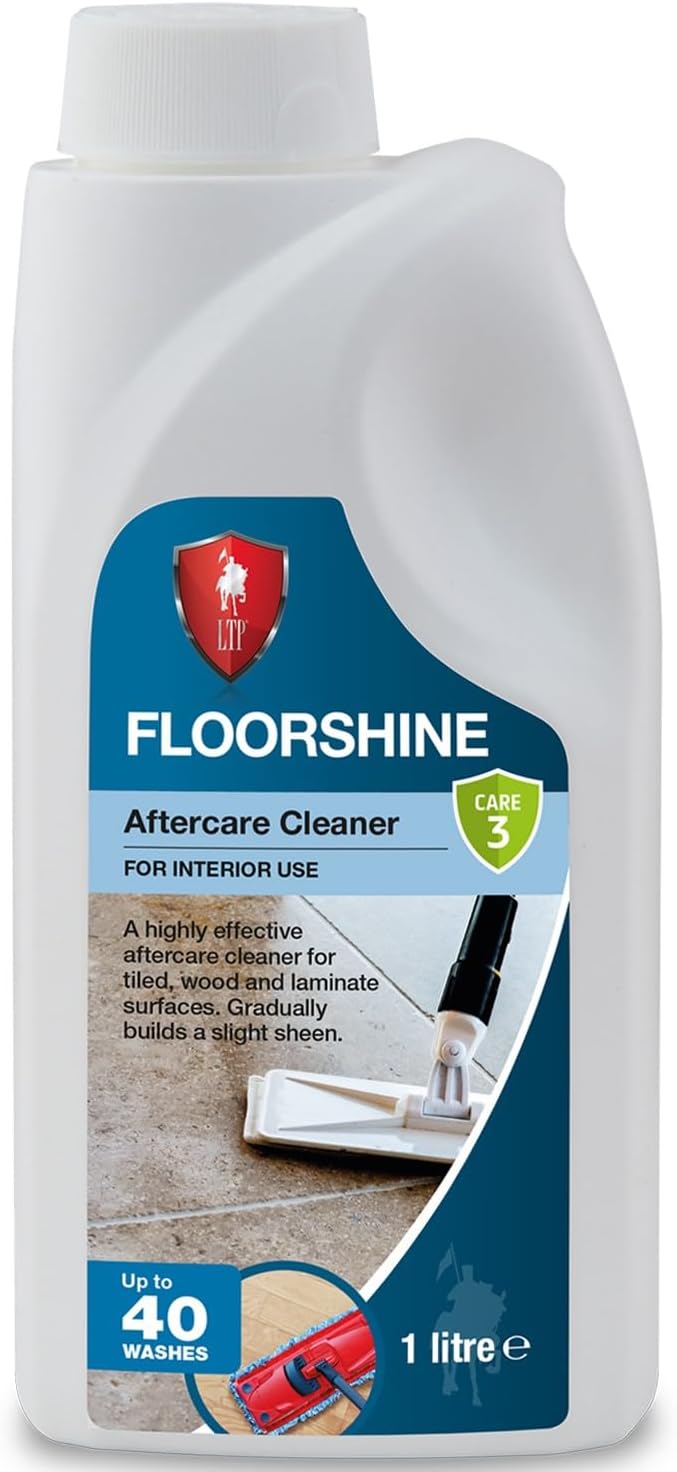
LTP Floorshine
|
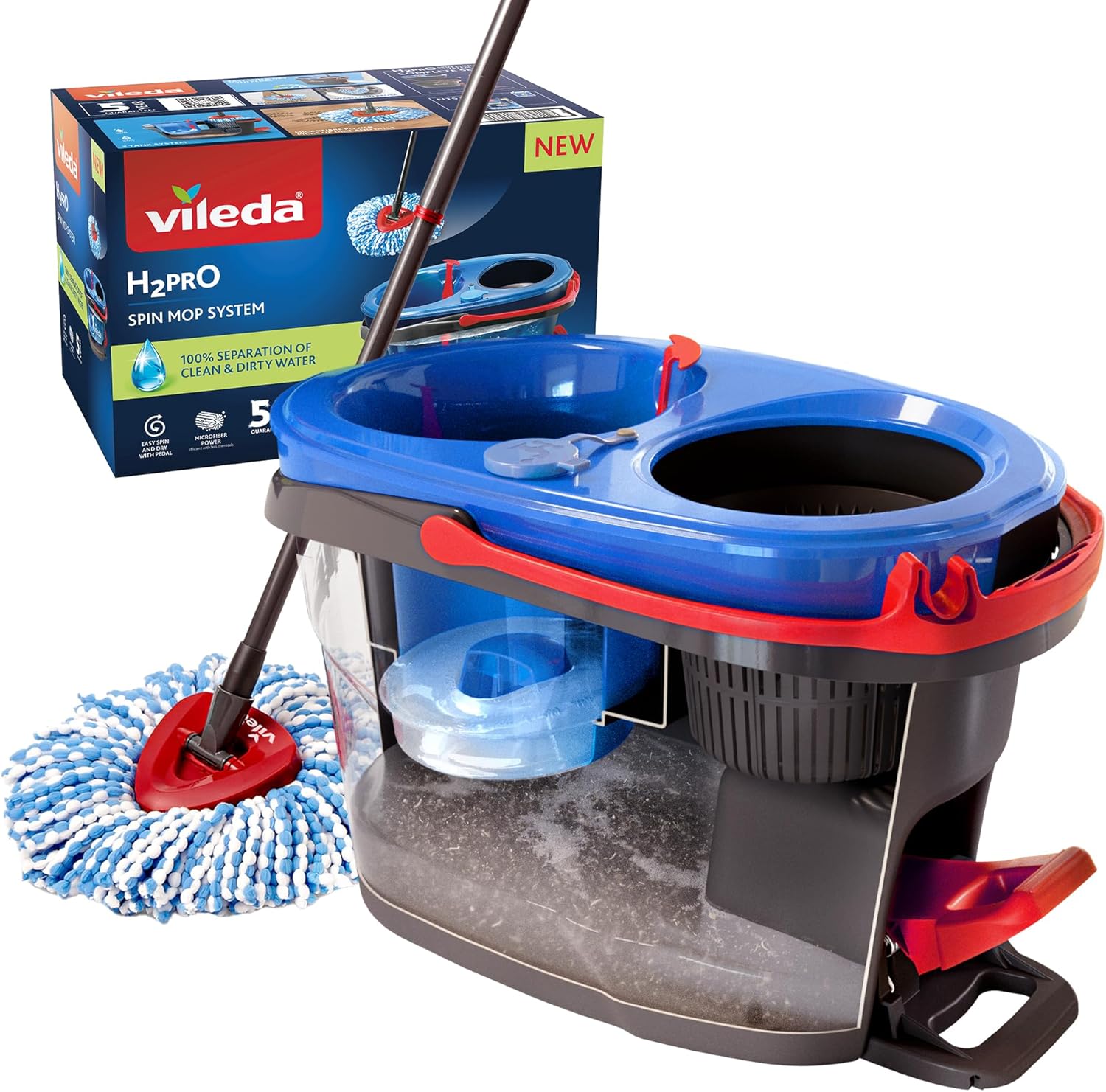
Vileda H2PrO Spin Mop System
|
Exploring Porosity: The Fundamental Cause of Dirt Accumulation on Terracotta
Terracotta is crafted from natural clay and subjected to firing at relatively low temperatures when compared to other tile options. This process results in a highly porous surface, which allows the tile to absorb moisture, oils, and dirt, functioning similarly to a sponge. In practical terms, this absorption means that grime can infiltrate deeply into the tile, making removal with standard cleaning techniques increasingly challenging.
Additionally, when terracotta is left unsealed, it becomes even more exposed. Without this protective barrier, minor spills or muddy footprints can leave lasting stains. Over time, this can lead to a dull, stained appearance that is tough to rectify without professional cleaning intervention.
How Does the Humid Climate in Surrey Accelerate Dirt Build-Up?
The environmental conditions in Surrey significantly influence how quickly Terracotta floors become dirty. The regular occurrence of rain and overall humidity levels in the area lead to increased moisture being tracked indoors, particularly in areas like entryways and conservatories.
Homes located near wooded regions or gardens face an even greater risk. Soil, pollen, and organic debris can easily find their way onto terracotta surfaces, especially if shoes are not removed before entering, which exacerbates the problem.
Everyday Habits That Contribute to Rapid Dirt Accumulation
In addition to environmental factors, daily practices can greatly worsen the situation. Utilizing inappropriate cleaning products—like acidic solutions or bleach—can degrade protective coatings and damage the tile surface. While steam mops are popular for cleaning, they often force moisture deeper into the tile, complicating the cleaning process.
High-traffic zones, such as kitchens and hallways, naturally endure greater wear and tear. Without regular sweeping and mopping, dirt can quickly accumulate and become embedded in the tile’s surface texture, making it increasingly challenging to clean.
Proactive Measures for Maintaining Pristine Terracotta Tiles
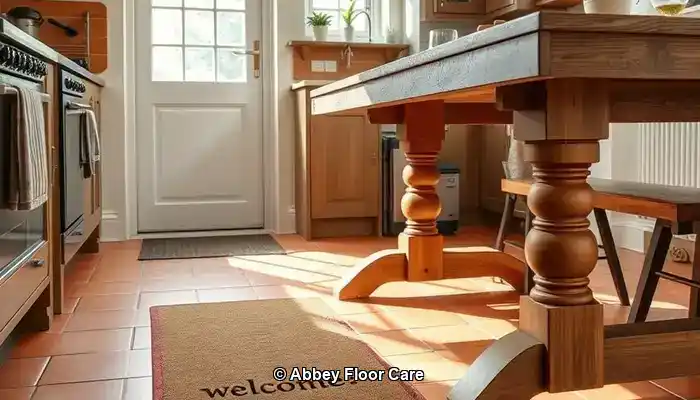
Maintaining terracotta floors in a clean state goes beyond merely responding to dirt; it necessitates proactive strategies to prevent dirt from accumulating in the first place. In Surrey, where damp weather and foot traffic from gardens are commonplace, continuous care is vital to preserving the innate beauty of terracotta tiles.
Sealing as Your Primary Defense Against Dirt
The most effective approach to prevent terracotta from becoming dirty quickly is to apply a suitable seal. Choosing a high-quality, breathable sealant establishes a protective layer that repels moisture, oils, and grime. This is particularly crucial for homes in Surrey, where fluctuating humidity levels can lead to moisture absorption that causes staining and mould growth.
Experts typically recommend resealing terracotta tiles every 12 to 18 months, depending on foot traffic and environmental exposure. Areas with heavy use, such as kitchens, hallways, and conservatories, may require more frequent sealing. Always opt for a sealant specifically formulated for porous stone and avoid glossy finishes that can draw in dirt.
Smart Design Decisions: The Benefits of Rugs and Mats
Strategically placed rugs and mats can significantly minimize the amount of dirt that comes into contact with your terracotta tiles. Heavy-duty doormats at entry points are particularly effective at trapping mud and moisture before they enter your home. In high-traffic spaces like hallways or beneath dining tables, area rugs serve as protective barriers against wear.
For areas linked to outdoor spaces, consider using washable runners that can be cleaned regularly. These not only help preserve the tiles but also enhance the warmth and aesthetic appeal of your home.
Effectively Controlling Moisture in Surrey Homes
The humid climate in Surrey can accelerate dirt accumulation on terracotta. To combat this issue, consider utilizing dehumidifiers in enclosed spaces and ensuring adequate ventilation throughout your residence. Promptly clean up spills and avoid leaving damp items, such as shoes or towels, on the floor.
If your terracotta flooring is located in a conservatory or garden room, contemplate installing blinds or UV filters to minimize condensation and protect against damage from sunlight. Small adjustments like these can greatly enhance the durability of your tiles over time.
By integrating effective sealing, smart design choices, and moisture control, homeowners in Surrey can significantly reduce the rate at which terracotta floors become dirty. In the following section, we will explore the most effective cleaning methods to keep your floors looking fresh and attractive day after day.
Optimal Cleaning Techniques for Terracotta Tiles
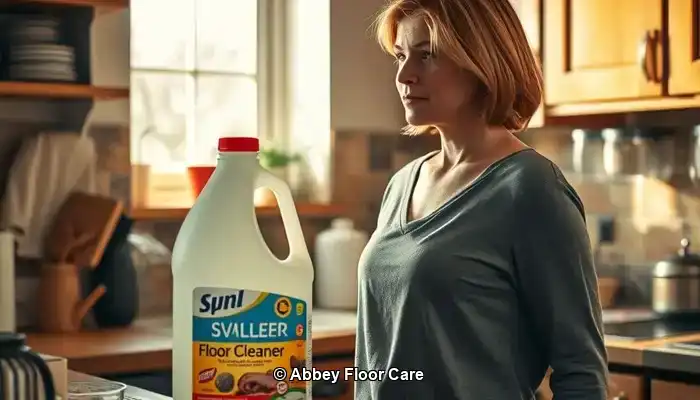
Even with proper sealing and preventative measures in place, terracotta floors demand regular attention to maintain their natural allure. The secret lies in employing the right cleaning techniques and products that are both effective and gentle on the tile’s porous surface.
Establishing Daily and Weekly Cleaning Routines
In Surrey homes, where outdoor elements frequently invade indoor spaces, daily sweeping or vacuuming is absolutely essential. Use a soft-bristle broom or a vacuum cleaner set to hard floor mode to effectively eliminate dust, debris, and organic matter before it settles into the tile.
For weekly cleanings, use warm water combined with a pH-neutral cleaner specifically designed for natural stone. It’s crucial to avoid soaking the floor—damp mopping is the recommended method. Excess water can seep into the tile and result in staining or mould growth, especially in older or inadequately sealed installations.
Choosing the Right Cleaning Products for Optimal Results
Select products that are both gentle and effective. Look for labels that state “stone-safe,” “non-acidic,” or “pH-neutral.” In Surrey, where eco-friendly living is increasingly important, many homeowners prefer biodegradable cleaners that are safe for both pets and children.
Steer clear of multi-surface cleaners that contain bleach, ammonia, or citrus extracts. These chemicals can strip away sealants and etch the terracotta, increasing susceptibility to future staining.
For stubborn stains, use a soft cloth and a diluted solution of a stone cleaner. Never scrub with abrasive pads or wire brushes, as these can scratch the surface and hinder future cleaning efforts.
Cleaning Methods to Avoid: Harsh Chemicals and Steam Cleaning
While steam mops may seem convenient, they are not suitable for terracotta. The high heat and moisture can penetrate the tile, weakening the sealant and causing long-term damage. Additionally, acidic cleaners such as vinegar or lemon juice—even when diluted—can erode the tile’s surface and cause discolouration.
Stick to gentle cleaning techniques and always test new products on a small, inconspicuous area before applying them to the entire floor.
Determining the Need for Professional Care Versus DIY Maintenance for Terracotta
Many homeowners in Surrey initially depend on DIY techniques to care for their terracotta floors. While regular sweeping and mopping can be beneficial, there comes a time when professional help is not just advantageous, but necessary.
When to Seek Assistance from a Surrey Tile Specialist?
If your terracotta tiles exhibit signs of deep staining, uneven colour, or surface wear, it’s wise to consult a professional. Specialists in Surrey utilize advanced equipment and stone-safe products that penetrate deeper than typical household cleaners. They can also evaluate whether your sealant is compromised and suggest an appropriate resealing schedule tailored to your home’s unique environment.
Restoration services typically encompass deep cleaning, stain removal, and the reapplication of breathable sealants that protect without altering the tile’s natural appearance. For older or heritage properties, experts can even replicate the original finish to maintain authenticity.
Cost Versus Longevity: Is Professional Help Worth the Investment?
While DIY cleaning may seem more cost-effective, it often leads to only temporary solutions. Without adequate sealing and thorough cleaning, dirt continues to accumulate, necessitating more frequent maintenance and risking permanent damage.
In contrast, professional care extends the lifespan of your terracotta floors. A single restoration service can rejuvenate colour, remove embedded grime, and safeguard the surface for months or even years. In high-traffic areas like kitchens or hallways, this investment pays off by reducing maintenance frequency and enhancing aesthetic appeal.
Homeowners in Surrey who prioritize long-term property care and visual attractiveness often find that professional services offer peace of mind and superior results. Additionally, many local providers present eco-friendly options and customized maintenance plans to fit your lifestyle.
Exploring Eco-Friendly and Safe Cleaning Solutions for Terracotta
The natural charm of terracotta deserves maintenance that aligns with environmentally conscious principles. For homeowners in Surrey aiming to keep their floors clean without compromising health or environmental integrity, eco-friendly cleaning options are the ideal solution. Fortunately, modern products and techniques make it easier than ever to protect your tiles and your household from harmful chemicals.
Selecting Non-Toxic Sealants and Cleaning Products
Conventional sealants often contain solvents that release volatile organic compounds (VOCs), which can linger in indoor air and negatively affect air quality. Today’s eco-friendly alternatives feature water-based formulations that are low in VOCs and safe for use around children and pets.
When choosing a cleaner, look for labels that specify “biodegradable,” “plant-based,” or “stone-safe.” These products are designed to lift dirt while preserving the porous surface of terracotta. Brands specializing in natural stone care frequently offer concentrated solutions that can be diluted for everyday use, reducing waste and packaging.
Safe Solutions for Households with Pets and Children
In bustling Surrey homes, safety is as crucial as cleanliness. Avoid bleach, ammonia, and acidic cleaners like vinegar, which can damage the tile and pose risks to pets and small children. Instead, opt for gentle formulations derived from coconut oil derivatives, citrus enzymes, or mineral-based ingredients.
For those who enjoy DIY methods, a simple blend of warm water and a few drops of castile soap can be surprisingly effective for light cleaning. Always remember to test any homemade solution on a small area first to ensure it does not interfere with the sealant or finish.
Adopting Sustainable Cleaning Practices for Terracotta Maintenance
Eco-friendly maintenance involves more than just products; it includes routines as well. Opt for reusable microfiber cloths and mops instead of disposable options. Regular sweeping helps to minimize the need for frequent wet cleaning. Furthermore, when resealing, choose products with recyclable packaging and a minimal environmental footprint.
Numerous floor care professionals in Surrey now offer green cleaning packages that utilize certified non-toxic products and sustainable methods. If you’re unsure of where to begin, consider scheduling a consultation with a local expert who can help create an effective and eco-conscious maintenance routine.
Strategies for Preserving the Pristine Appearance of Your Terracotta Floors
<a href="https://limitsofstrategy.com/terracotta-clean-tips-for-maintaining-lasting-freshness/">Terracotta flooring</a> imparts warmth and timeless elegance to Surrey homes, yet its porous nature demands careful attention to maintain cleanliness and vibrancy. By understanding the factors contributing to quick dirt accumulation, properly sealing the tiles, and adopting effective cleaning habits, you can significantly reduce grime buildup and extend the longevity of your tiles.
Whether managing a busy household or restoring a historic property, consistency is crucial. Daily sweeping, using pH-neutral cleaning solutions, and seasonal resealing greatly enhance the upkeep of your floors. Moreover, if stains or wear become evident, do not hesitate to contact a local specialist for professional restoration.
Utilizing eco-friendly products and safe cleaning techniques ensures your floors remain beautiful without compromising health or environmental standards. With the right strategies in place, terracotta can continue to be a stunning feature in your home for years to come.
Are you ready to safeguard your floors with a smart approach? Contact us today for expert terracotta maintenance tailored to the unique conditions of Surrey. Let’s ensure your home remains at its best—naturally.
Common Inquiries About Terracotta Maintenance
Terracotta floors may be timeless, yet they necessitate specific care to uphold their beauty. Below are responses to the most frequently asked questions from homeowners in Surrey eager to keep their tiles clean, protected, and visually appealing.
How Frequently Should I Reseal My Terracotta Tiles?
In most Surrey homes, terracotta should be resealed every 12 to 18 months. However, this frequency can vary based on foot traffic, moisture exposure, and whether the tiles are located indoors or outdoors. Areas such as kitchens, hallways, and conservatories may require more frequent resealing. If your tiles begin to absorb water or appear dull, it’s time to reseal them.
Is Vinegar or Bleach Safe for Use on Terracotta?
No—vinegar, bleach, and other acidic or harsh cleaners can significantly damage terracotta. These substances degrade sealants and etch the tile surface, leading to permanent discolouration. Always use pH-neutral, stone-safe cleaning products specifically formulated for porous flooring.
What is the Optimal Mop for Cleaning Terracotta Floors?
A microfiber mop is the best choice. It effectively captures dust and dirt without scratching the surface and uses minimal water, which is crucial for porous tiles like terracotta. Avoid sponge mops or steam mops, as they can oversaturate the tile and weaken the sealant.
Are DIY Cleaning Solutions Safe to Utilize?
Yes, but caution is important. A mild mixture of warm water and castile soap can be effective for light cleaning. Always test any homemade solution on a small, inconspicuous area first. Avoid anything acidic or abrasive, and do not use homemade cleaners on unsealed tiles.
What Actions Should I Take If My Tiles Have Already Stained?
For established stains, professional restoration services are your best recourse. Tile care specialists in Surrey can provide deep cleaning, remove embedded grime, and reseal the surface to restore the tile’s original colour and texture. DIY methods may worsen the damage if improper products are used.
The Article Tired of Dirty Terracotta? How to Keep It Clean Longer first found on https://www.abbeyfloorcare.co.uk
The Article Dirty Terracotta: Tips for Keeping It Clean Longer appeared first on https://fabritec.org
The Article Terracotta Cleaning Tips for Long-Lasting Shine Was Found On https://limitsofstrategy.com
Leave a Reply